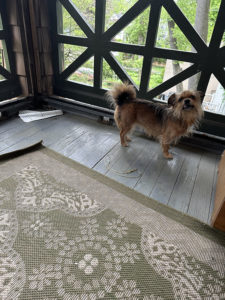This post originally appeared on Murder Is Everywhere.

From where I sit, the view has changed. The windows which once offered views of my neighbors’ houses are now filled with nothing but green. The elms, oaks, and cherry trees have leafed out, giving a false appearance that summer has arrived. However, the temperatures in Maryland are still mostly in the fifties, not the eighties. It’s still coat weather. Still, how can my mood keep from jumping ahead?
Summer is a mindset shift. My hope for the next four months is that I’ll have a magical, intensive time writing and reading. It will happen two different ways: some of the weeks, starting in July, will involve leaving here to tour a few areas of the country; not a bad time to be gone, given that July and August are quite hot. Therefore, it makes sense for me to start thinking like it’s summer while it’s still spring. And this means it’s time to set up my treetop office.
To be clear, I’m not in a tree fort, nor is it one of those trendy structures you see in AirBnB ads, a house built in a tree. I’m safely in my house, but also outdoors on roof level, writing on the house’s western-facing sleeping porch.
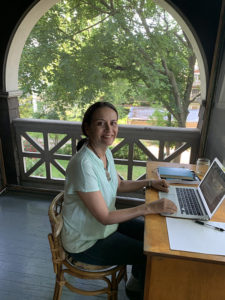
I didn’t know what a sleeping porch was until we bought this house. Basically, it’s an outdoor living area that was typically built during the Victorian and Edwardian periods in North America, especially in the American South, where summer nights are usually hot and humid, and the Northeastern states and Canada, where many summer cottages for the wealthy were built from 1890 through 1920.
Elevated porch sleeping areas were believed to provide protection against tuberculosis and other contagious diseases, as well as providing relief from the heat. Some people were able to afford mosquito wire (aka screens) that further protected family members from insect bites. They were very popular in the period between 1910 and 1920, when homeowners added them on as renovations, the way we might add a mudroom or a family room to a house today. Our house was built in 1897 with the sleeping porches an integral part of the original design. Old-time electric lamps hang from the porch ceilings, which seems more evidence that these spaces were intended for socializing, game playing and reading before bedtime.

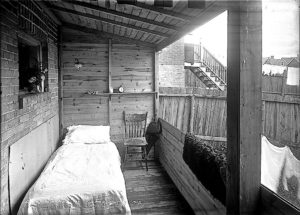
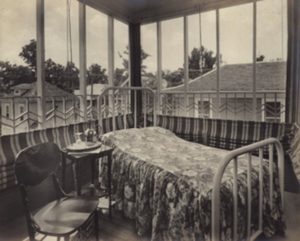
Our house is extremely symmetrical, and it has a matched pair of second story sleeping porches that are defined by grand, Romanesque arches. The porch on the east side of the house catches the sunrise, while the western sleeping porch is very hot and sunny from noon onward. Our house has a third floor that’s just above the porches. Up there, we found two places with rotting wooden strips of porch and damaged railings that indicated a rough gesture of comfort for servants. We removed these balconies, which seemed more hazardous than lovely. We put in new screens on the second floor porches and repainted and retained them, and a whole new world opened up.
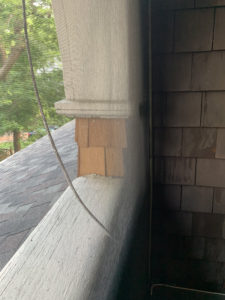
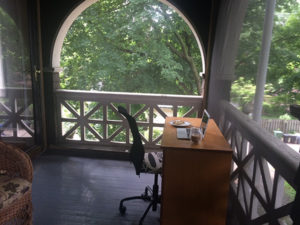
Although I can’t wait to set myself up on the sleeping porch, my back starts to twinge when I think about the floor maintenance. When I was cleaning the porch’s woodwork recently with Murphy’s Oil Soap and water, I thought of others who have done the same job the same over the last 125 years. In 1897, the neighborhood trees would have been seedlings, and without car traffic, there would be less airborne pollution. Yet, given what I’ve read in historical novels about household maintenance, the servants probably had to wipe clean the porches several times a week. I hate the pain of vigorous cleaning, but I can always stop when I want, ignoring a spiderweb or errant leaf.
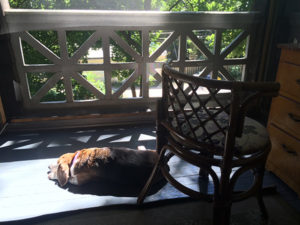
This week, I’ve made a lot of plans to clean the porch floor that have resulted in procrastination. The gray floors have so much pollen that they are pea green; not even my dog will lie down on them. After the floors are swept and mopped, I will lay down the outdoor rugs that I vacuumed before storing indoors over the winter. When I drag in the porch’s vintage rattan and wicker furniture, the porch is buzzing with energy that has nothing to do with our carpenter bees.
Year round, I do my writing in the morning; there are tables or desks in various rooms to suit my whim. On the sleeping porch, I’ve used a cheap, child-sized plywood desk from second-hand shop that I didn’t mind leaving out all year. And I got what I deserved: the old desk is starting to sag from ten years of porch life. This year, I’ve decided to junk the desk and replace it with a new desk that’s adult sized, and has iron legs and a surface made from mango wood, a sustainable, inexpensive hardwood that does better outdoors than most woods. And this desk should be nice enough to bring inside during the winter.
One piece I’ll probably never replace is an extra-long wicker chaise that I bought for $50 on Craigslist. I had a very long fresh cushion covered in outdoor fabric made for it, and now it’s the perfect place for reading, and of course, sleeping. Its generous width and high back made it extremely difficult to pass through a door out to the porch. Therefore we bring in the cushions, but not the chair, in the off-season. So far, so good.
But nobody really looks at the furniture. The best thing about the porch are views right into the high branches of the trees. I’m captivated as I see squirrels chase each other along branches and then jump like Olympic athletes to the next tree and finish up by springing onto our roof. Sometimes, a squirrel explores all the way up to the edge of the screen separating us. At the sight of me, or my tiny snarling dog, the squirrel shoots back to a safer zone.
The bird songs are quite exquisite, and I‘m sorry to admit that I can’t recognize the singers by name. When it rains, I sit in comfort while hearing the drama of falling drops and feeling the whooshing of damp wind against my skin.
When we are outdoors among trees, we go into what scientists call soft focus. The trees and sky and animals become part of a pleasant blur. Soft focus frees the dreams lurking in the subconscious.
My goal this summer is to write approximately 1000 words a day, seven days a week. Sometimes, the sentences pour out and the duty is all done by ten in the morning. Yet there are just as many days when the process is slower.
I believe the only way to overcome my writing challenges is to show up for them every day. Just like the squirrels and birds come to the trees, doing their own important work.
